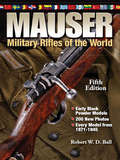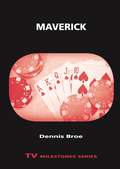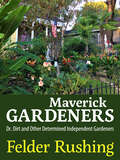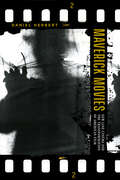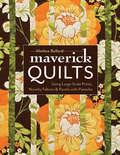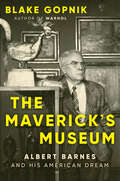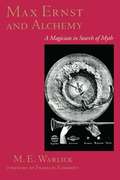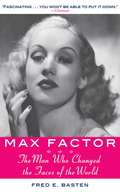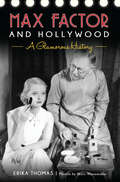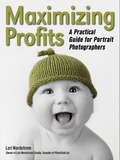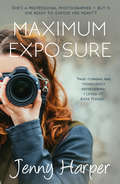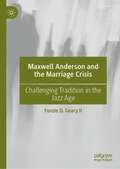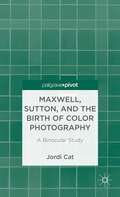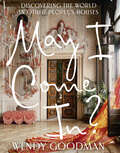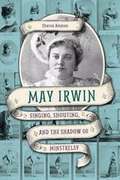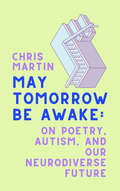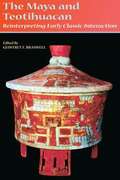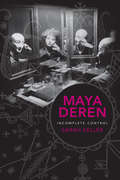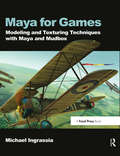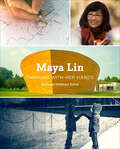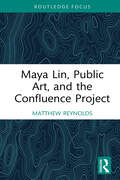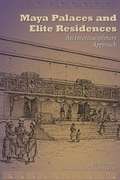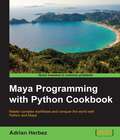- Table View
- List View
Mauser Military Rifles of the World
by Robert W. BallMore Models - More Photos - More HistoryRobert Ball, the world's foremost authority on Mauser military rifles, continues to scour the continents in search of more details and models of this ubiquitous rifle. His years of research and expertise culminate in this definitive, full-color Mauser reference.In this new edition, you'll find:Previously unknown variationsRare coverage of experimental weapons and prototypesMeticulously cataloged descriptions, historical backgrounds, model specifics and markings, and detailed photographsOne of a kind, this edition is the most exhaustive reference ever for Mauser military rifles!
Maverick (TV Milestones Series)
by Dennis BroeAiring on ABC from 1957 to 1962, Maverick appeared at a key moment in television Western history and provided a distinct alternative to the genre's usual moralistic lawmen in its hero, Bret Maverick. A non-violent gambler and part-time con man, Maverick's principles revolved around pleasure and not power, and he added humor, satire, and irony to the usually grim-faced Western. In this study of Maverick, author Dennis Broe details how the popular series mocked, altered, and undermined the characteristics of other popular Westerns, like Gunsmoke and Bonanza. Broe highlights the contributions made by its creators, its producer, Roy Huggins, and its lead actor, James Garner, to a format that was described as "the American fairy tale." Broe describes how Garner and Huggins struck blows against a feudal studio system that was on its last legs in cinema but was being applied even more rigidly in television. He considers Maverick as a place where multiple counter-cultural discourses converged--including Baudelaire's Flaneur, Guy DeBord's Situationists, and Jack Kerouc's Beats--in a form that was acceptable to American households. Finally, Broe shows how the series' validation of Maverick's outside-the-law status punctured the Cold War rhetoric promoted by the "adult" Western. Broe also highlights the series' female con women or flaneuses, who were every bit the equal of their male counterparts and added additional layers to the traditional schoolteacher/showgirl Western dichotomy. Broe demonstrates the progressive nature of Maverick as it worked to counter the traditional studio mode of production, served as a locus of counter-cultural trends, and would ultimately become the lone outpost of anti-Cold War and anti-establishment sentiments within the Western genre. Maverick fans and scholars of American television history will enjoy this close look at the classic series.
Maverick Gardeners: Dr. Dirt and Other Determined Independent Gardeners
by Felder Rushing“Be forewarned that this book honors people like the woman in my hometown who paints the numbers of her favorite NASCAR drivers on her elephant ears, and a Tokyo gardener with over a hundred bonsai plants.” So says renowned garden journalist Felder Rushing in his new book Maverick Gardeners: Dr. Dirt and Other Determined Independent Gardeners. In this book, Felder delves deeply into the psychology of what motivates and sustains the Keepers of the Garden Flame. For thousands of years, a loosely connected web of unique, nontraditional gardeners has bonded people across race, culture, language, and other social conventions through sharing unique plants and stories. Found in nearly every neighborhood worldwide, these “determined independent gardeners” (DIGrs) are typically nonjoiners who garden simply and exuberantly, eschewing customary horticultural standards in their amateur pursuits of personal bliss. Included in Maverick Gardeners are classic “passalong plant” lists, a dollop of how-to, numerous color photographs, and thought-provoking essays on quintessential tools, sharing with others, getting away with wildflowers in suburbia, and organizing a plant swap. The centerpiece of this unique gardening journey is the no-holds-barred story of a ten-year cross-cultural collaboration between the horticulturist author and a flamboyant rebellious gardener who called himself Dirt. Through swapping plants and garden lore—and rubbing shoulders with fellow DIGrs—they unraveled their shared humanity. From the practical to the inspiring, Maverick Gardeners is the perfect book for those nonconformist souls who see no sense in trying to fit in and follow the footpaths of others.
Maverick Movies: New Line Cinema and the Transformation of American Film
by Daniel HerbertA free ebook version of this title is available through Luminos, University of California Press’s Open Access publishing program. Visit www.luminosoa.org to learn more.Maverick Movies tells the improbable story of New Line Cinema, a company that cut a remarkable path through the American film industry and movie culture. Founded in 1967 as an art film distributor, New Line made a small fortune running John Waters's Pink Flamingos at midnight screenings in the 1970s and found reliable returns with the Nightmare on Elm Street franchise in the 1980s. By 2001, the company competed with the major Hollywood studios and reached global box office success with the Lord of the Rings franchise. Blurring boundaries between high and low culture, between independent film and Hollywood, and between the margins and the mainstream, New Line Cinema epitomizes Hollywood's shift in focus from the mass audience fostered by the classic studios to the multitude of niche audiences sought today.
Maverick Quilts: Using Large-Scale Prints, Novelty Fabrics & Panels with Panache
by Alethea BallardTurn bold and unusual fabrics into stunningly beautiful quilts with this guide to creative yet surprisingly simple patterns.Fabrics that feature unique, colorful, or graphic designs can be as irresistible as they are challenging. How do you cut and arrange such beautiful fabric to use in a quilt? Art quilter Aletha Ballard provides the answer in Maverick Quilts. Alethea combines straightforward instruction on the basics of quilting with ten versatile and creative projects that are perfect for showing off bold designs and large-scale prints. Easy to follow and beautifully illustrated, Maverick Quilts show you just how easy it is to sew wild, joyful, colorful quilts with the fabrics you love.
The Maverick's Museum: Albert Barnes and His American Dream
by Blake GopnikA fascinating biography of the philanthropist Albert Barnes, whose pioneering collection of modern art was meant to transform America’s soulFrom prominent critic and biographer Blake Gopnik comes a compelling new portrait of America’s first great collector of modern art, Albert Coombs Barnes. Raised in a Philadelphia slum shortly after the Civil War, Barnes rose to earn a medical degree and then made a fortune from a pioneering antiseptic treatment for newborns. Never losing sight of the working-class neighbors of his youth, Barnes became a ruthless advocate for their rights and needs. His vast art collection—181 Renoirs, 69 Cézannes, 59 Matisses, 46 Picassos—was dedicated to enriching their cultural lives. A miner was more likely to get access than a mine owner.Gopnik’s meticulous research reveals Barnes as a fierce advocate for the egalitarian ideals of his era’s progressive movement. But while his friends in the movement worked to reshape American society, Barnes wanted to transform the nation’s aesthetic life, taking art out of the hands of the elite and making it available to the average American.The Maverick’s Museum offers a vivid picture of one of America’s great eccentrics. The sheer ferocity of Barnes’s democratic ambitions left him with more enemies than allies among people of all classes, but for a circle of intimates, he was a model of intelligence, generosity, and loyalty. In this compelling portrait, Gopnik reveals a life shaped by contradictions, one that left a lasting impact.
Max Ernst and Alchemy: A Magician in Search of Myth
by M. E. WarlickSurrealist artist Max Ernst defined collage as the "alchemy of the visual image." Students of his work have often dismissed this comment as simply a metaphor for the transformative power of using found images in a new context. Taking a wholly different perspective on Ernst and alchemy, however, M. E. Warlick persuasively demonstrates that the artist had a profound and abiding interest in alchemical philosophy and often used alchemical symbolism in works created throughout his career.
Max Factor: The Man Who Changed the Faces of the World
by Fred E. BastenNice women never wore makeup. Even the word was taboo in polite society--until Max Factor entered the scene. Born in Poland in 1877, Factor worked as a beautician for the Russian royal family, the Romanovs. In 1904, he fled to America, where he opened a cosmetics store in Los Angeles. Creating makeup originally for silent films, then the talkies, and, ultimately, color motion pictures, Factor designed looks for Katharine Hepburn, Rita Hayworth, Bette Davis, and countless other beauties of the day. Soon women everywhere wanted to look like their favorite glamorous stars, and Factor was there to help, bringing his innovative cosmetics to the general public. He revolutionized the world of beauty by producing many firsts: false eyelashes, lip gloss, foundation, eye shadow, the eyebrow pencil, concealer, wand-applicator mascara, and water-resistant makeup. A true innovator, he also introduced the concept of color harmony and the celebrity-endorsed cosmetics advertising that forms the glamorous backbone of the modern industry. Max Factor was the father of modern makeup. This is his extraordinary story.
Max Factor and Hollywood: A Glamorous History
by Erika ThomasThe story of the makeup artist who changed the film industry—and the world of modern cosmetics. Includes photos. When Polish wigmaker and cosmetician Max Factor arrived in Los Angeles at the dawn of the motion picture industry, &“make-up&” had been associated only with stage performers and ladies of the oldest profession. Appalled by the garish paints worn by actors, Factor introduced the first &“flexible&” greasepaint for film in 1914. With a few careful brush strokes, a lot of innovation, and the kind of luck that can happen only in Hollywood, Max Factor changed the meaning of glamour. His innovations can be experienced in every tube of lipstick, palette of eye shadow, and bottle of nail lacquer used today. Join author Erika Thomas as she reveals the makeup guru's expert beauty tips and the story of how he created the most iconic golden-era looks that are as relevant today as they were nearly a century ago.
Maximizing Profits
by Lori NordstromIf you’ve got great camera skills and want to take the plunge and make your passion a career, you’ll need to build a solid business foundation from which your passion and creativity can take flight. If you’re like most artists, the business side of things seems a bit dry-and it may be something you dread. Fortunately, Lori Nordstrom takes the sting out of your studies and gives you all of the skills you need to plan your business, attract the attention of the clientele you want to serve, recruit a staff that supports your creative and financial objectives, create a top-notch customer-service experience, and show and sell your unique images to happy clients, time after time. Lori Nordstrom is an award-winning photographer and an active lecturer and blogger who inspires other photographers to make smart business decisions that positively impact the children-and-family portrait industry as a whole. In this book, she’s compiled her hard-won tips, sharing clear, simple ideas for developing your personal style; identifying your ideal client base, creating a referral system, constructing displays, getting media coverage, and hosting events. She’ll also help you understand how to hire a staff, create a budget, schedule your time, manage your workflow, and establish a sense of value and a cost structure that allows for a nice profit. Because all of your pre-session efforts should lead to a successful photographic experience for your clients, special attention is given to cultivating a standout studio experience that allows clients to feel relaxed, happy, and yes, pampered. Nordstrom also helps readers work through some issues that are notoriously challenging for photographers-breaking free of pricing set points, selling their products, and overcoming client objections to close the sale. This book offers a fresh, exciting, and friendly approach to building a sustainable business that affords photographers the opportunity to confidently create-and make a great living.
Maximum Exposure (The\heartlands Ser.)
by Jenny HarperShe’s a professional photographer – but is she ready to expose her heart?Adorable but scatterbrained newspaper photographer Daisy Irvine becomes the key to the survival of The Hailesbank Herald when her boss drops dead right in front of her. And while big egos and petty jealousies hinder the struggle to save the paper, Daisy starts another campaign – to win back her ex, Jack Hedderwick.Ben Gillies, returning after a long absence, sees childhood friend Daisy in a whole new light. He’d like to win her love, but discovers that she’s a whole lot better at taking photographs than making decisions, particularly when she’s blinded by the past.When tragedy strikes Daisy’s family, loyalty drives her home. But it’s time to grow up and Daisy must choose between independence and love.
Maxwell Anderson and the Marriage Crisis: Challenging Tradition in the Jazz Age
by Fonzie D. Geary IIThis book focuses on the re-evaluation of four Maxwell Anderson plays within the context of the emergence of the New Woman and the perception of a marriage crisis in the United States during the 1920s. The four plays under consideration are White Desert (1923), Sea-Wife (1924), Saturday’s Children (1927), and Gypsy (1929). These plays are largely forgotten and, even when the titles appear in Anderson scholarship, coverage has tended to be cursory and dismissive. This work represents a fresh approach and re-assessment of an American playwright who bore a significant impact on the drama of his time, serving not only to place Anderson’s work more effectively within the context of American theatre during the 1920s, but also to bridge the gap between his work and the marriage-related plays of the late twentieth and early twenty-first centuries.
Maxwell, Sutton and the Birth of Color Photography: A Binocular Study
by Jordi CatThis focused and incisive study reassesses the historic collaboration between James Clerk Maxwell and Thomas Sutton. It reveals that Maxwell and Sutton were closer to true partners than has commonly been assumed, and shows how their experiments illuminate the role of technology, representation, and participation in Maxwell's natural philosophy.
May I Come In?: Discovering the World in Other People's Houses
by Wendy GoodmanNew York magazine&’s interiors editor shares some of her most memorable house profiles in this stunning and inspiring visual tour. For May I Come In?, design editor extraordinaire Wendy Goodman visits seventy homes that express their owners&’ spirit and passions. In this pantheon, imagination and originality hold sway: Artists and eccentrics are the equals of aristocrats and the mandarins of design. Alba Clemente&’s closet is a Renaissance theater; Amy Sedaris built a playroom (but not for children); Andrew Solomon houses his guests in an igloo; Richard Avedon&’s private walls were bulletin boards; Kathy Ruttenberg&’s house is an animal kingdom; Jay Maisel called a former bank with seventy-two rooms home. Every room has a story to tell and a purpose for being. A self-described design hunter, Goodman spent thirty years seeking extraordinary living spaces. In her long career, she has found three things to be true. The first is that curiosity and never giving up will get you everywhere. The second is what Diana Vreeland stated best when she wrote, &“Few things are more fascinating than the opportunity to see how other people live during private hours.&” The third is that houses never lie. These principles underscore her search for individuality, human interest, and authenticity in design.May I Come In? is profusely illustrated with superb images by leading interior photographers, as well as Goodman&’s own snapshots and memorabilia related to her quests. It is an irresistible visual record of the art of living by one of its most astute observers.&“Page after page reveals interiors that practically vibrate with charisma, while others wax a poetic minimalism that, despite a lack of things, overwhelm with grace.&” —Vogue &“When it comes to the New York design scene, Wendy Goodman is positively an institution.&” —Town & Country
May Irwin: Singing, Shouting, and the Shadow of Minstrelsy
by Sharon AmmenMay Irwin reigned as America's queen of comedy and song from the 1880s through the 1920s. A genuine pop culture phenomenon, Irwin conquered the legitimate stage, composed song lyrics, and parlayed her celebrity into success as a cookbook author, suffragette, and real estate mogul. Sharon Ammen's in-depth study traces Irwin's hurly-burly life. Irwin gained fame when, layering aspects of minstrelsy over ragtime, she popularized a racist "Negro song" genre. Ammen examines this forgotten music, the society it both reflected and entertained, and the ways white and black audiences received Irwin's performances. She also delves into Irwin's hands-on management of her image and career, revealing how Irwin carefully built a public persona as a nurturing housewife whose maternal skills and performing acumen reinforced one another. Irwin's act, soaked in racist song and humor, built a fortune she never relinquished. Yet her career's legacy led to a posthumous obscurity as the nation that once adored her evolved and changed.
May Tomorrow Be Awake: On Poetry, Autism, and Our Neurodiverse Future
by Chris MartinAn author and educator’s pioneering approach to helping autistic students find their voices through poetry—a powerful and uplifting story that shows us how to better communicate with people on the spectrum and explores how we use language to express our seemingly limitless interior lives.Adults often find it difficult to communicate with autistic students and try to “fix” them. But what if we found a way to help these kids use their natural gifts to convey their thoughts and feelings? What if the traditional structure of language prevents them from communicating the full depth of their experiences? What if the most effective and most immediate way for people on the spectrum to express themselves is through verse, which mirrors their sensory-rich experiences and patterned thoughts?May Tomorrow Be Awake explores these questions and opens our eyes to a world of possibility. It is the inspiring story of one educator’s journey to understand and communicate with his students—and the profound lessons he learned. Chris Martin, an award-winning poet and celebrated educator, works with non-verbal children and adults on the spectrum, teaching them to write poetry. The results have been nothing short of staggering for both these students and their teacher. Through his student’s breathtaking poems, Martin discovered what it means to be fully human.Martin introduces the techniques he uses in the classroom and celebrates an inspiring group of young autistic thinkers—Mark, Christophe, Zach, and Wallace—and their electric verse, which is as artistically dazzling as it is stereotype-shattering. In telling each of their stories, Martin illuminates the diverse range of autism and illustrates how each so-called “deficit” can be transformed into an asset when writing poems. Meeting these remarkable students offers new insight into disability advocacy and reaffirms the depth of our shared humanity. Martin is a teacher and a lifelong learner, May Tomorrow Be Awake is written from a desire to teach and to learn—about the mind, about language, about human potential—and the lessons we have to share with one other.
The Maya and Teotihuacan: Reinterpreting Early Classic Interaction
by Geoffrey E. BraswellSince the 1930s, archaeologists have uncovered startling evidence of interaction between the Early Classic Maya and the great empire of Teotihuacan in Central Mexico. <P><P>Yet the exact nature of the relationship between these two ancient Mesoamerican civilizations remains to be fully deciphered. Many scholars have assumed that Teotihuacan colonized the Maya region and dominated the political or economic systems of certain key centers--perhaps even giving rise to state-level political organizations. Others argue that Early Classic rulers merely traded with Teotihuacan and skillfully manipulated its imported exotic goods and symbol sets to increase their prestige.
Maya Deren: Incomplete Control (Film and Culture Series)
by Sarah KellerMaya Deren (1917–1961) was a Russian-born American filmmaker, theorist, poet, and photographer working at the forefront of the American avant-garde in the 1940s and 1950s. Influenced by Jean Cocteau and Marcel Duchamp, she is best known for her seminal film Meshes of the Afternoon (1943), a dream-like experiment with time and symbol, looped narrative and provocative imagery, setting the stage for the twentieth-century's groundbreaking aesthetic movements and films.Maya Deren assesses both the filmmaker's completed work and her numerous unfinished projects, arguing Deren's overarching aesthetic is founded on principles of incompletion, contingency, and openness. Combining the contrasting approaches of documentary, experimental, and creative film, Deren created a wholly original experience for film audiences that disrupted the subjectivity of cinema, its standards of continuity, and its dubious facility with promoting categories of realism. This critical retrospective reflects on the development of Deren's career and the productive tensions she initiated that continue to energize film.
Maya Deren
by Sarah KellerAssesses both the filmmaker's completed work and her numerous unfinished projects, arguing Deren's overarching aesthetic is founded on principles of incompletion, contingency, and openness
Maya for Games: Modeling and Texturing Techniques with Maya and Mudbox
by Michael IngrassiaWell-known Maya professional, Michael Ingrassia, takes readers through his unique style of modeling: "Image Based Modeling" where efficient, realistic models can be created very quickly. Ingrassia's techniques allow modelers to create exact replicas of their concept characters or objects. The techniques presented are very efficient and allow game modelers to quickly build out stand alone props to populate environments and game levels. Presented are tried and true techniques that the author has used successfully in game production for the past 10 years. Most, if not all 3D books, focus on basic "box" modeling techniques, which are the basis for proper 3D modeling but not the complete solution. In the author's experience, students who have learned through the Image Based Modeling brand, have quickly excelled into effective modelers. One of the hardest things for any modeler to do is match their model EXACTLY to the concept art or photos they are provided. The insider tips in this book walk artists through this process. Artists begin with basic modeling and advance to a creating a complete scene and set design/game level. Rather than including sporadic models with zero association from to one another, each model in the book becomes an integral part of an overall theme realistic in game development today. The accompanying downloadable resources include 8 exclusive video tutorials on advanced Maya techniques as bonus tracks for artists providing invaluable modeling, rigging and texturing samples. Also, an in-depth video on assembling a "Killer Demo Reel" showing simple but effective video editing techniques used by the author so that artists can learn how to get their work seen. The book not only teaches effective methodology, but provides the user with impressive content for producing effective demo reels and portfolios. Pros and cons of demo reel, website and artist representation are given, along with insights into the expectations of game studios today. The video tutorials show users the finished product, and then run through the process of step by step creation of that particular technique.
Maya Lin: Artist-Architect of Light and Lines
by Jeanne Walker HarveyThe bold story of Maya Lin, the visionary artist-architect who designed the Vietnam Veterans Memorial.You may be familiar with the iconic Vietnam Veterans Memorial. But do you know about the artist-architect who created this landmark?As a child, Maya Lin loved to study the spaces around her. She explored the forest in her backyard, observing woodland creatures, and used her house as a model to build tiny towns out of paper and scraps. The daughter of a clay artist and a poet, Maya grew up with art and learned to think with her hands as well as her mind. From her first experiments with light and lines to the height of her success nationwide, this is the story of an inspiring American artist: the visionary artist-architect who designed the Vietnam Veterans Memorial.A Christy Ottaviano Book
Maya Lin: Thinking with Her Hands
by Susan Goldman RubinThe Vietnam Veterans Memorial in Washington, D.C., is one of the most famous pieces of civic architecture in the world. But most people are not as familiar with the reserved college student who entered and won the design competition to build it. This accessible biography tells the story of Maya Lin, from her struggle to stick with her vision of the memorial to the wide variety of works she has created since then. The carefully researched text, paired with ample photos, crosses multiple interests—American history, civic activism, art history, and cultural diversity—and offers a timely celebration of the memorial's 35th anniversary as well as providing an important contribution to the current discussion of the role of women and minorities in society.
Maya Lin, Public Art, and the Confluence Project (Routledge Focus on Art History and Visual Studies)
by Matthew ReynoldsThe first scholarly monograph devoted exclusively to this vital work of contemporary public art, this book examines Maya Lin’s Confluence Project through the lens of environmental humanities and Indigenous studies. Matthew Reynolds provides a detailed analysis of each earthwork, along with a discussion of the proposed final project at Celilo Falls near The Dalles, Oregon. The book assesses the artist’s longtime engagement with the region of the Pacific Northwest and explores the Confluence Project within Lin’s larger oeuvre. Several consistent themes and experiences are common amongst all the sites. These include an emphasis on individual, multisensory encounters with the earthworks and their surrounding contexts; sound as an experiential dimension of landscape; indexical accounts of the multicultural, multispecies histories of each place; and an evocation of loss. The book will be of interest to scholars working in art history, contemporary art, environmental studies, environmental humanities, and Native American studies.
Maya Palaces and Elite Residences: An Interdisciplinary Approach
by Jessica Joyce ChristieMaya "palaces" have intrigued students of this ancient Mesoamerican culture since the early twentieth century, when scholars first applied the term "palace" to multi-room, gallery-like buildings set on low platforms in the centers of Maya cities. Who lived in these palaces? What types of ceremonial and residential activities took place there? How do the physical forms and spatial arrangement of the buildings embody Maya concepts of social organization and cosmology? This book brings together state-of-the-art data and analysis regarding the occupants, ritual and residential uses, and social and cosmological meanings of Maya palaces and elite residences. A multidisciplinary team of senior researchers reports on sites in Belize (Blue Creek), Western Honduras (Copan), the Peten (Tikal, Dos Pilas, Aguateca), and the Yucatan (Uxmal, Chichen-Itza, Dzibilchaltun, Yaxuna). Archaeologist contributors discuss the form of palace buildings and associated artifacts, their location within the city, and how some palaces related to landscape features. Their approach is complemented by art historical analyses of architectural sculpture, epigraphy, and ethnography. Jessica Joyce Christie concludes the volume by identifying patterns and commonalties that apply not only to the cited examples, but also to Maya architecture in general.
Maya Programming with Python Cookbook
by Adrian HerbezMaster complex workflows and conquer the world with Python and Maya About This Book * Improve your modelling skills and reduce your scripting problems using Python in Maya * Learn to communicate with web applications using Python for easier team development * A quick and practical answer to every problem you can have whilst scripting in Maya with Python Who This Book Is For This book is for Python developers who have just started scripting with Maya. What You Will Learn * Find out how to use Python scripting to automate tedious tasks * Create functional user interfaces to make scripts easy to share with others * Add new functionality to Maya via the power of scripting * Import and export arbitrary data into and out of Maya * Improve your workflow, and that of your team * Create custom create custom controls to make rigs that are easy to work with * Implement a system to render 3D assets for isometric games * Use script jobs to trigger actions automatically in response to user interaction * Open a command port to allow other applications to communicate with Maya In Detail Maya is a 3D graphics and animation software, used to develop interactive 3D applications and games with stupendous visual effects. The Maya Programming with Python Cookbook is all about creating fast, powerful automation systems with minimum coding using Maya Python. With the help of insightful and essential recipes, this book will help you improve your modelling skills. Expand your development options and overcome scripting problems encountered whilst developing code in Maya. Right from the beginning, get solutions to complex development concerns faced when implementing as parts of build. Style and approach This book is comprised of a set of practical recipes, grouped under specific topics, which can be referred to independently or in sequence. These recipes provide quick solutions to common problems, and cover most of the real-world scenarios that developers are likely to face when working with Maya.
